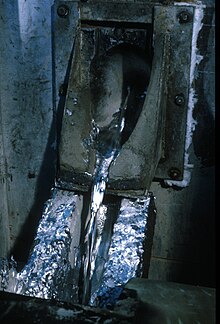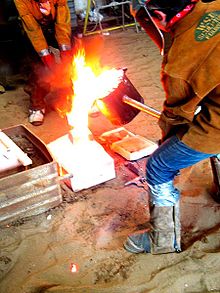
Back Gietwerk Afrikaans سبك Arabic Fosa (metal·lúrgia) Catalan Slévárenství Czech Хатĕрлевлĕх CV Metalstøbning Danish Gießen (Metall) German Fundición Spanish Galdaketa Basque ریختهگری فلز Persian


In metalworking and jewelry making, casting is a process in which a liquid metal is delivered into a mold (usually by a crucible) that contains a negative impression (i.e., a three-dimensional negative image) of the intended shape. The metal is poured into the mold through a hollow channel called a sprue. The metal and mold are then cooled, and the metal part (the casting) is extracted. Casting is most often used for making complex shapes that would be difficult or uneconomical to make by other methods.[1]
Casting processes have been known for thousands of years, and have been widely used for sculpture (especially in bronze), jewelry in precious metals, and weapons and tools. Highly engineered castings are found in 90 percent of durable goods, including cars, trucks, aerospace, trains, mining and construction equipment, oil wells, appliances, pipes, hydrants, wind turbines, nuclear plants, medical devices, defense products, toys, and more.[2]
Traditional techniques include lost-wax casting (which may be further divided into centrifugal casting, and vacuum assist direct pour casting), plaster mold casting and sand casting.
The modern casting process is subdivided into two main categories: expendable and non-expendable casting. It is further broken down by the mold material, such as sand or metal, and pouring method, such as gravity, vacuum, or low pressure.[3]
- ^ Degarmo, Black & Kohser 2003, p. 277
- ^ "About Metalcasting | American Foundry Society". Archived from the original on 2023-06-07. Retrieved 2021-01-12.
- ^ Degarmo, Black & Kohser 2003, p. 278
© MMXXIII Rich X Search. We shall prevail. All rights reserved. Rich X Search